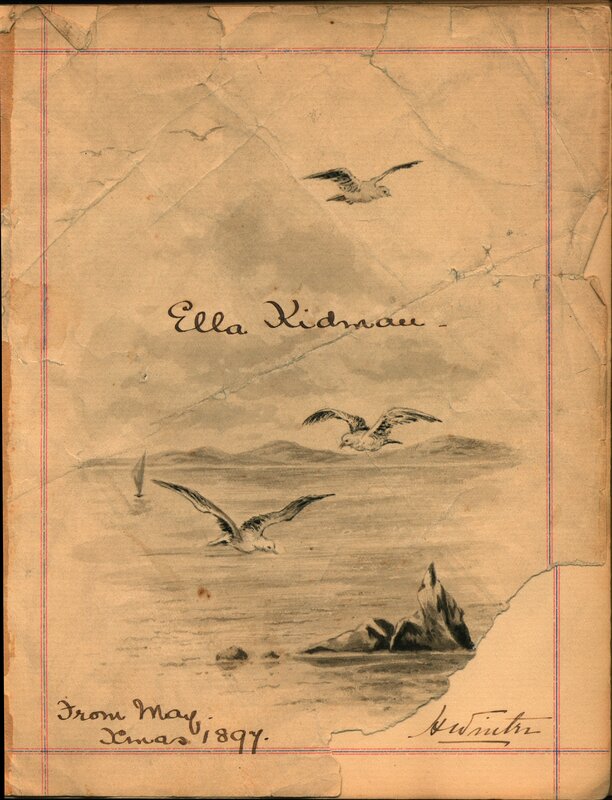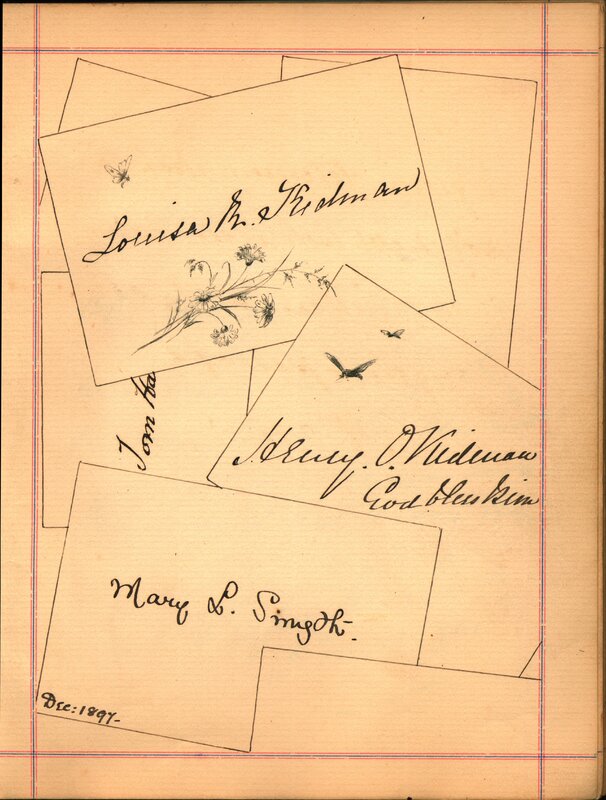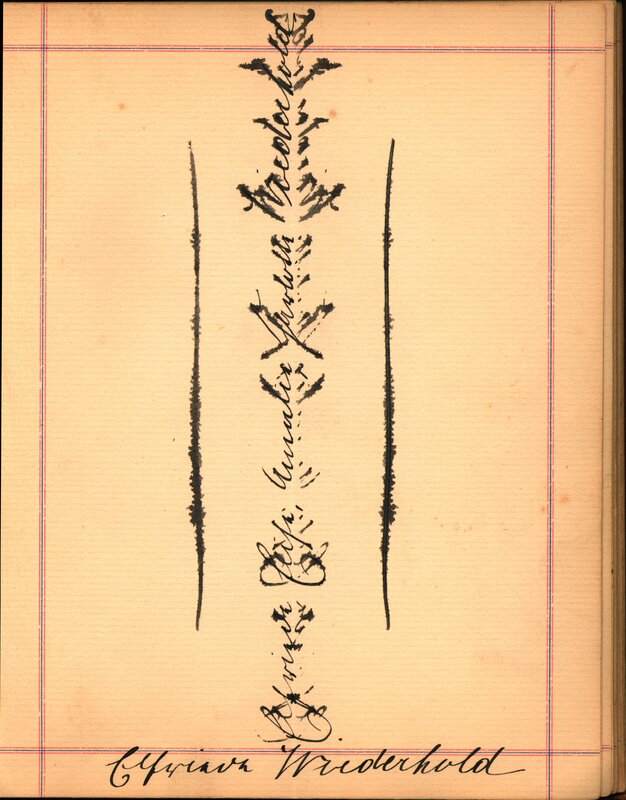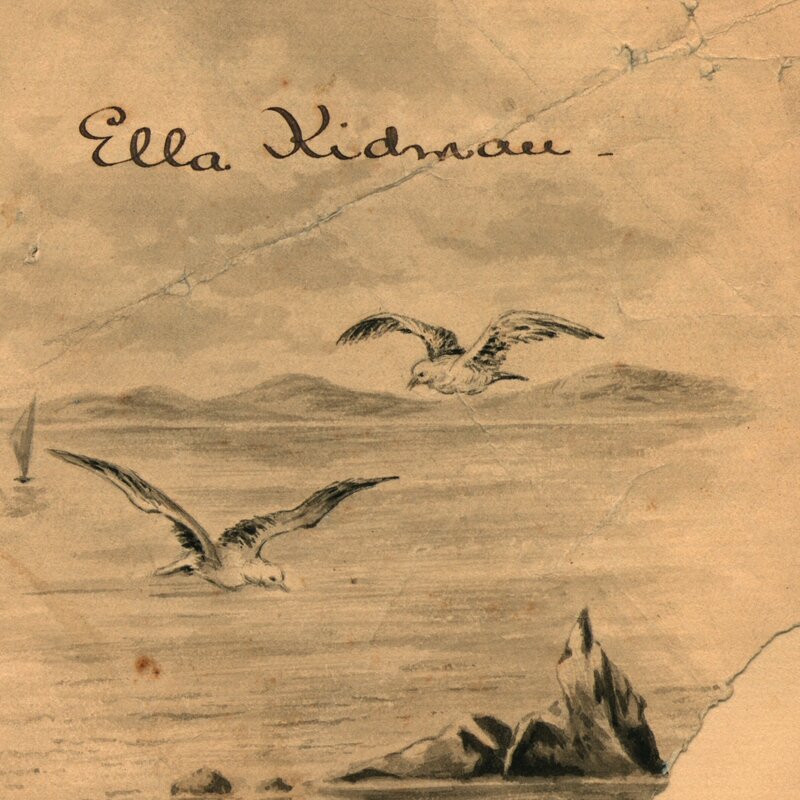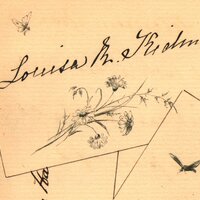Ella Kidman’s Autograph Album
Item
-
Title
-
Ella Kidman’s Autograph Album
-
Description
-
The first page, or “ownership page,” of Ella Kidman’s autograph album features its owner’s name prominently at the centre of its elaborate design. Kidman’s cursive handwriting is framed by a detailed ink drawing of an ocean scene: three seagulls coast above the water, drawing the viewer’s eye to the indication of clouds behind them and to a mountain range on the horizon. A cluster of jagged rocks juts out of the water below the seagulls; beyond this rock formation is a small sailboat. At the bottom left corner of the page are the words “from May. / Xmas 1897.” The album’s paper shows wear from the passage of time; it is wrinkled in places and fully torn at the bottom right corner.
Another page of Kidman’s album is decorated with layered rectangular shapes. Framed by these superimposed shapes are the signatures of Kidman’s friends and family. The uppermost rectangle features an illustration of a bundle of flowers lying horizontally on its side; opposite the flowers is a small illustration of a butterfly. In the shape below, two small winged insects decorate the top left corner of the rectangle.
A third page shows a skeleton-like shape running the length of the page. The design has been created with black ink and is almost perfectly symmetrical, bisecting the page down the middle. These distinctive shapes are called ink blot signatures or ghost signatures. To create an ink blog signature, album signers would fold the paper over their wet signatures and then re-open the page to reveal their unique ghostly signatures.
-
ELIZABETH BASSETT ON WHAT THIS OBJECT TEACHES US:
Little is known about Ella Kidman, the owner of this autograph album, other than that she was the third eldest child of a farming family from Hertfordshire, England. Elizabeth Bassett tells us that Kidman immigrated to New York in 1911, was married, and then moved to Canada a few years later.
Bassett explains that the ownership page of Kidman’s album is typical of Victorian autograph albums in featuring the owner’s name prominently on an elaborately designed page. Though Kidman’s ink drawing of seagulls flying above the ocean is exceptional, Bassett notes that it is not uncommon for autograph album title pages to be the most elaborately designed page of the volume. As the bottom left corner of Kidman’s ownership page indicates, she received her album as a Christmas gift in 1897. Kidman was 17 at the time, and Bassett remarks that it is easy to imagine her decorating the title page, eagerly anticipating future additions to her personalized book. Indeed, Kidman ended up adding to this album for an impressively long time: the album’s final entry is from 1930. However, the contents of the album show that it was used less and less frequently throughout her life. For the most part, the album represents Kidman’s life from the ages of 17 to 30.
Bassett notes that Kidman’s album is an example of a friendship autograph album. The distinguishing feature of friendship albums is that they were created collaboratively, though they usually had only one owner. Albums such as this one were passed among friends and family members, with each person signing their name in the album’s pages. The blank pages of the album afforded the signers creativity when it came to their signatures. Often, Bassett explains, they would also inscribe poetry, song lyrics, or even drawings. It is not unusual to find inside jokes or other fragments of memories included in the pages of these albums.
Bassett suggests that Victorian autograph albums constitute an early form of social media. As in today’s social media, there were trends in how autograph albums were used. For example, Bassett notes that the page decorated with layered rectangular shapes resembles pages from other autograph albums from this time in Britain and North America. The rectangular shapes were meant to imitate calling cards, mementos that Victorians left for their hosts after a social visit. A tray full of calling cards was often displayed as a visualization of social circles; these pages have a strikingly similar visual effect.
Another autograph album trend is illustrated by subsequent pages in the album featuring ink blot signatures, which became popular by the end of the Victorian era. The practice of collecting ink blot signatures, Bassett explains, was inspired by a mid-century interest in klecksography, the practice of making art out of ink blots.
The Ella Kidman album was donated to the University of Victoria Libraries along with two other scrapbooks created by the Kidman family, including a matching autograph album created by Ella Kidman’s sister Lilian. The Lilian Kidman album also includes examples of the calling card design and ghost signatures. Examining these two albums together (as in Bassett’s digital exhibit; see the link below) may prompt viewers to reflect on scrapbooking as a collaborative process.
-
Contributor
-
Elizabeth Bassett is an early career librarian and archivist, having recently completed her dual Masters of Archival Studies and Library and Information Studies at the University of British Columbia.
See all items with this value
-
Allegra Stevenson-Kaplan is a member of the Crafting Communities team.
See all items with this value
